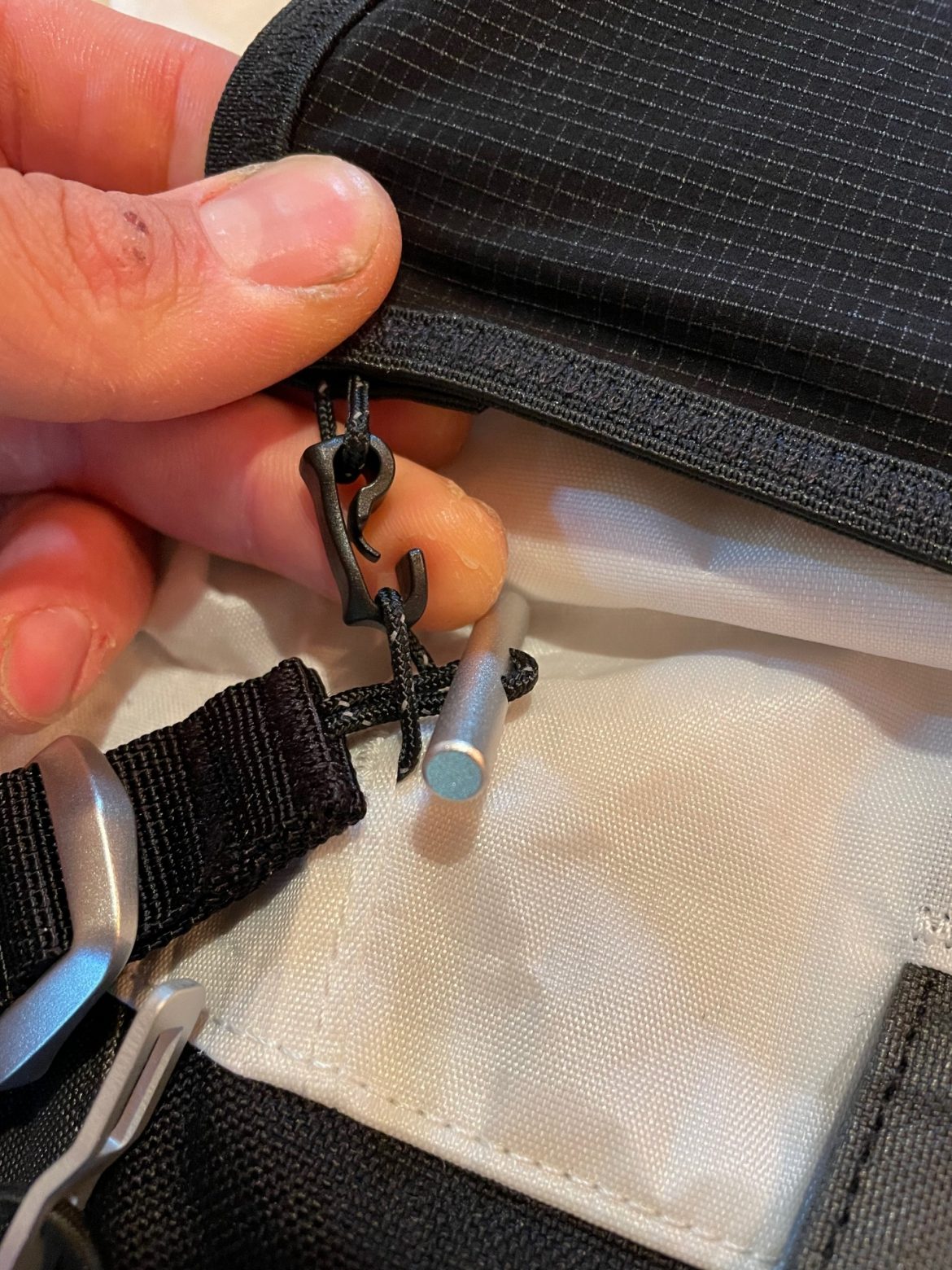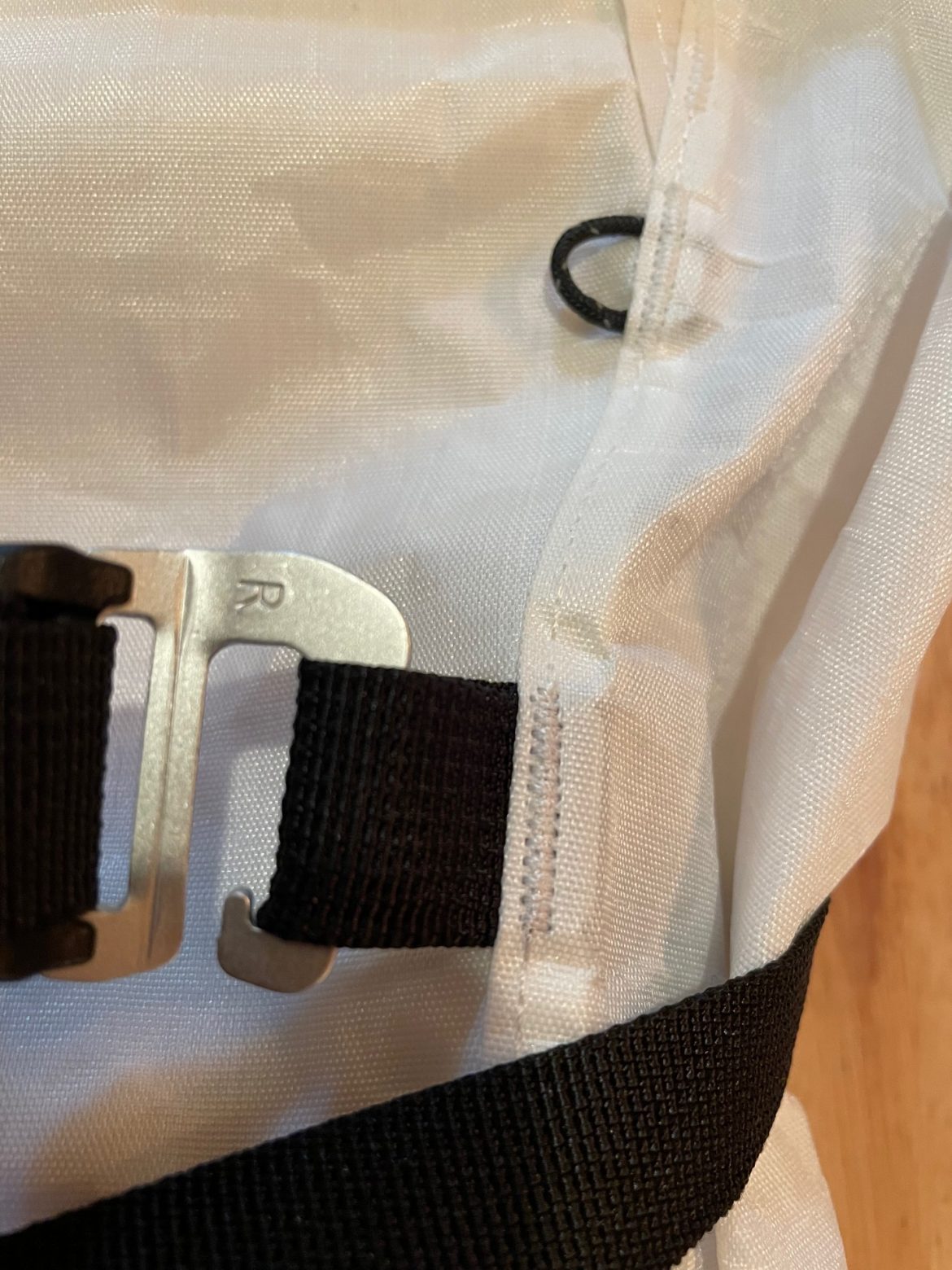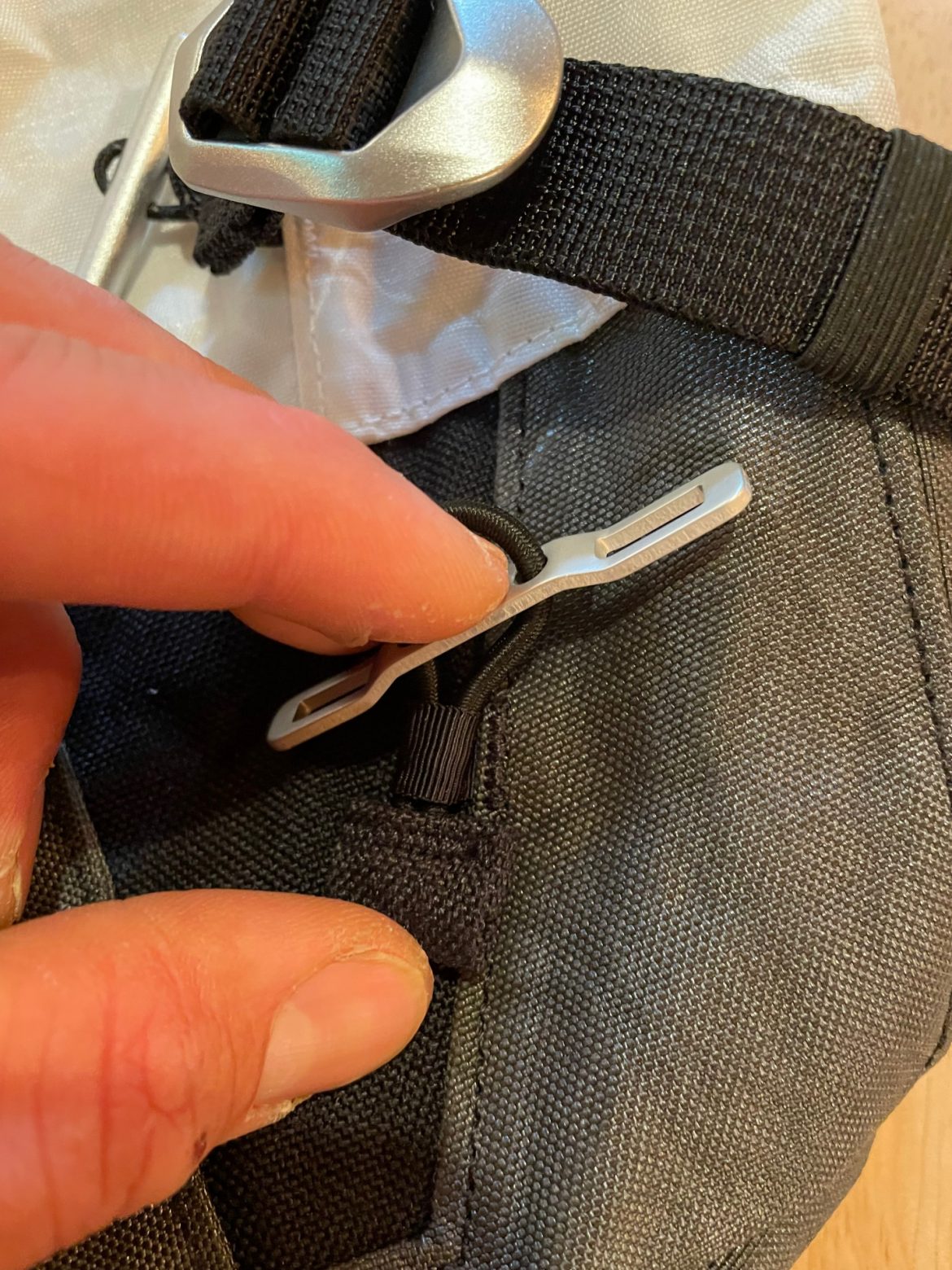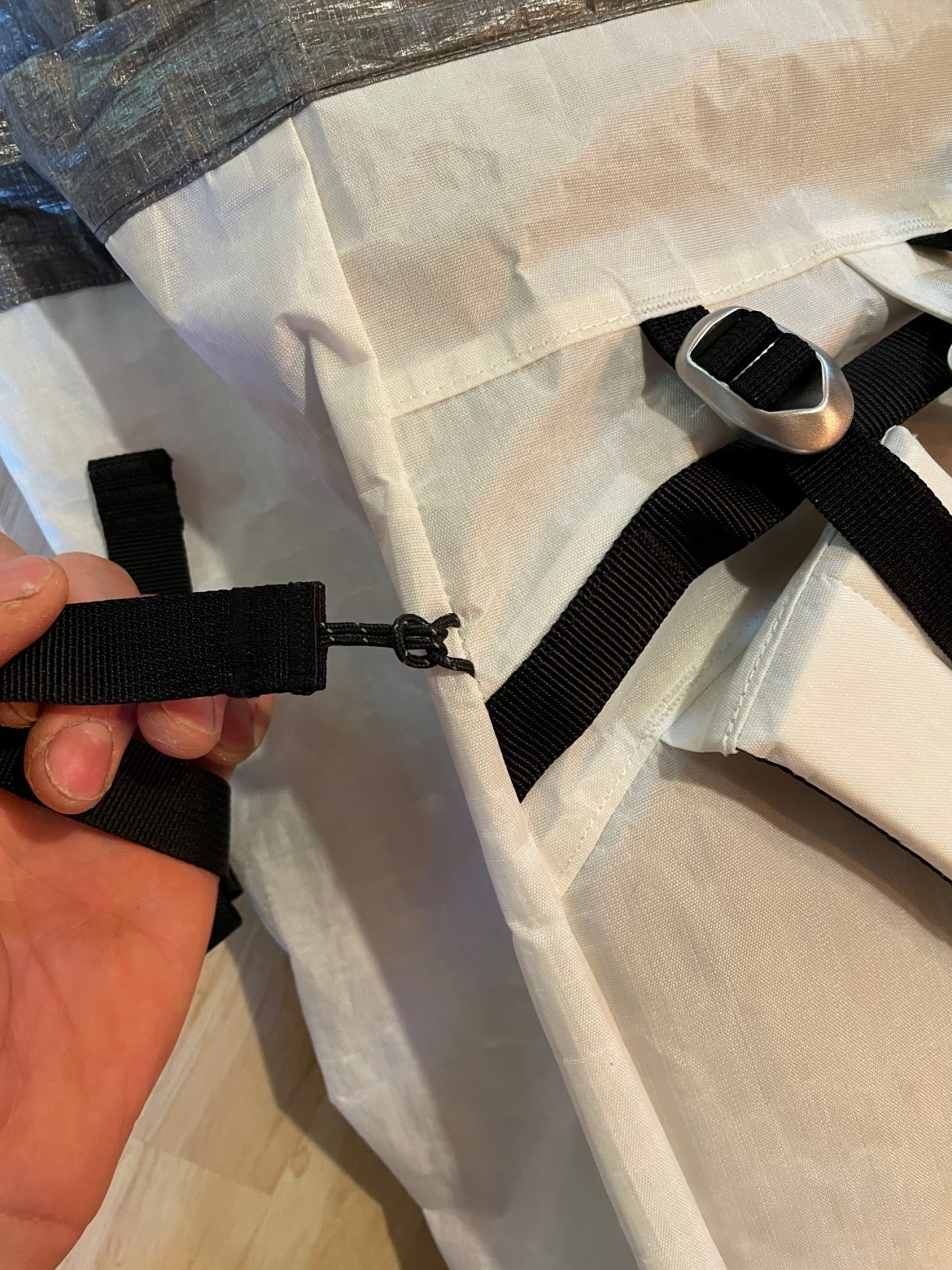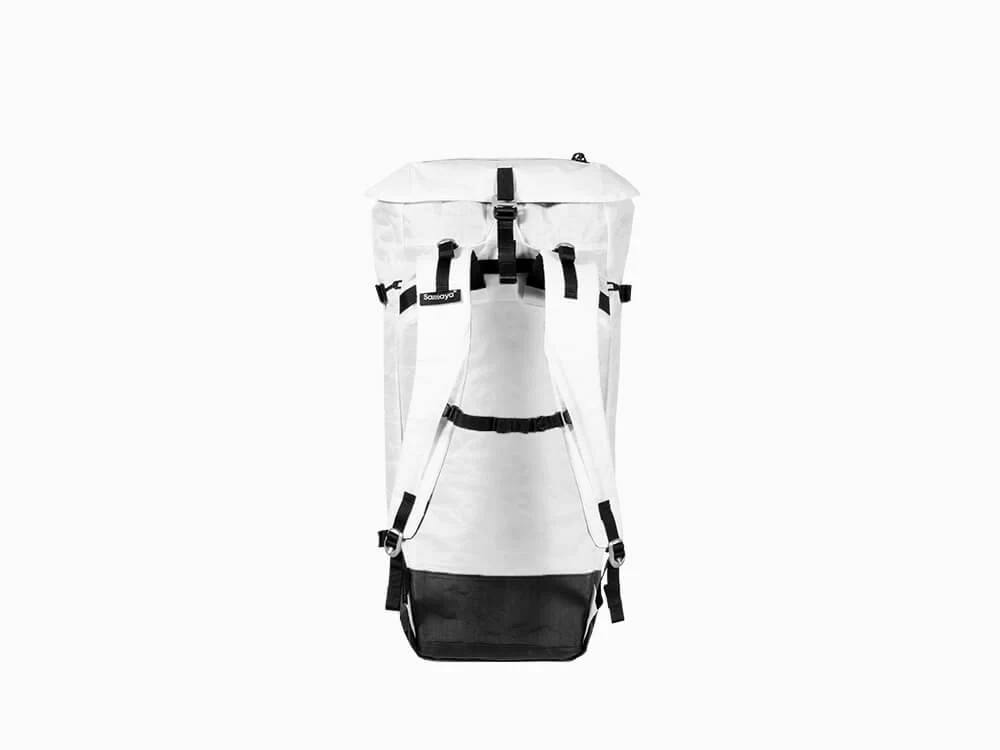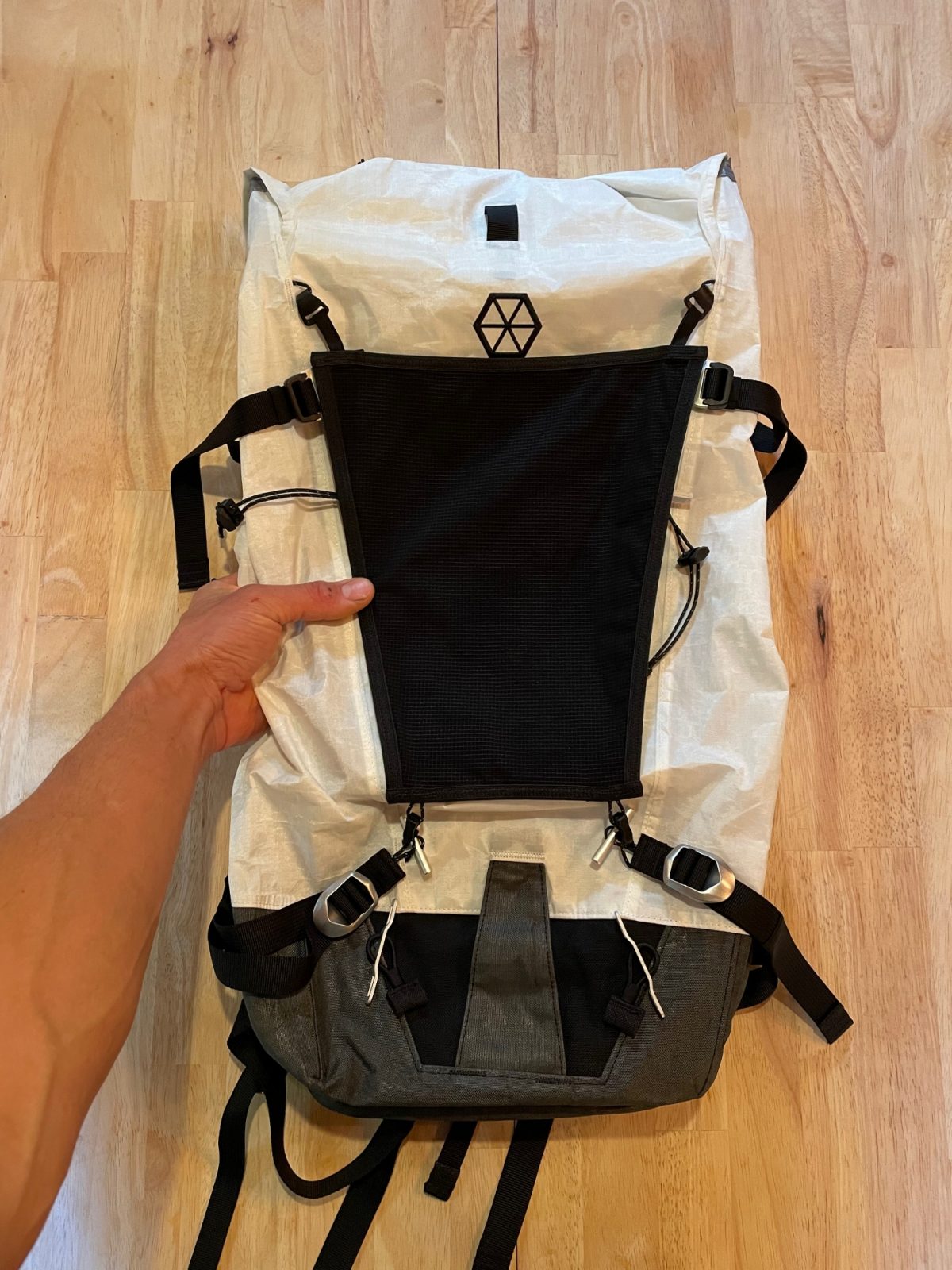
The Samaya ULTRA35 just out of the box. Shown with all accessories attached. The pack weighs 840g fully featured and 435g full paired down.
New to the Stateside scene of tents and packs, Samaya, an Annecy based company focuses on gear for the alpine. As skiers and boarders combine projects involving technical climbing and snow sliding descents, Samaya’s ULTRA35 pack is built for the mission. Here’s our first look.
Samaya is likely to be a new name to the WildSnow readership. Based in Annecy, France (“near Chamonix,” their website states reassuringly), the company has historically catered to the world of haute alpinism in the actual (read: European) Alpine. They’re now looking to expand their reach to the US market. Known among European alpinists primarily for their durable, ultra-lightweight, Dyneema-construction four-season tents, the Ultra35 is Samaya’s foray into the world of high-performance, ultra-light alpine packs and clearly represents an effort to transfer the company’s considerable tent construction know-how to this new medium.
As a site covering backcountry skiing and ski mountaineering, we know some out there who trend towards ski alpinism. Sometimes a full blown waist belt, suspension system, or even an avalanche safety pocket are add-on features that make for a more cumbersome experience. The Samaya Ultra35 likely speaks to those pairing things down for a more ethereal mountain experience.
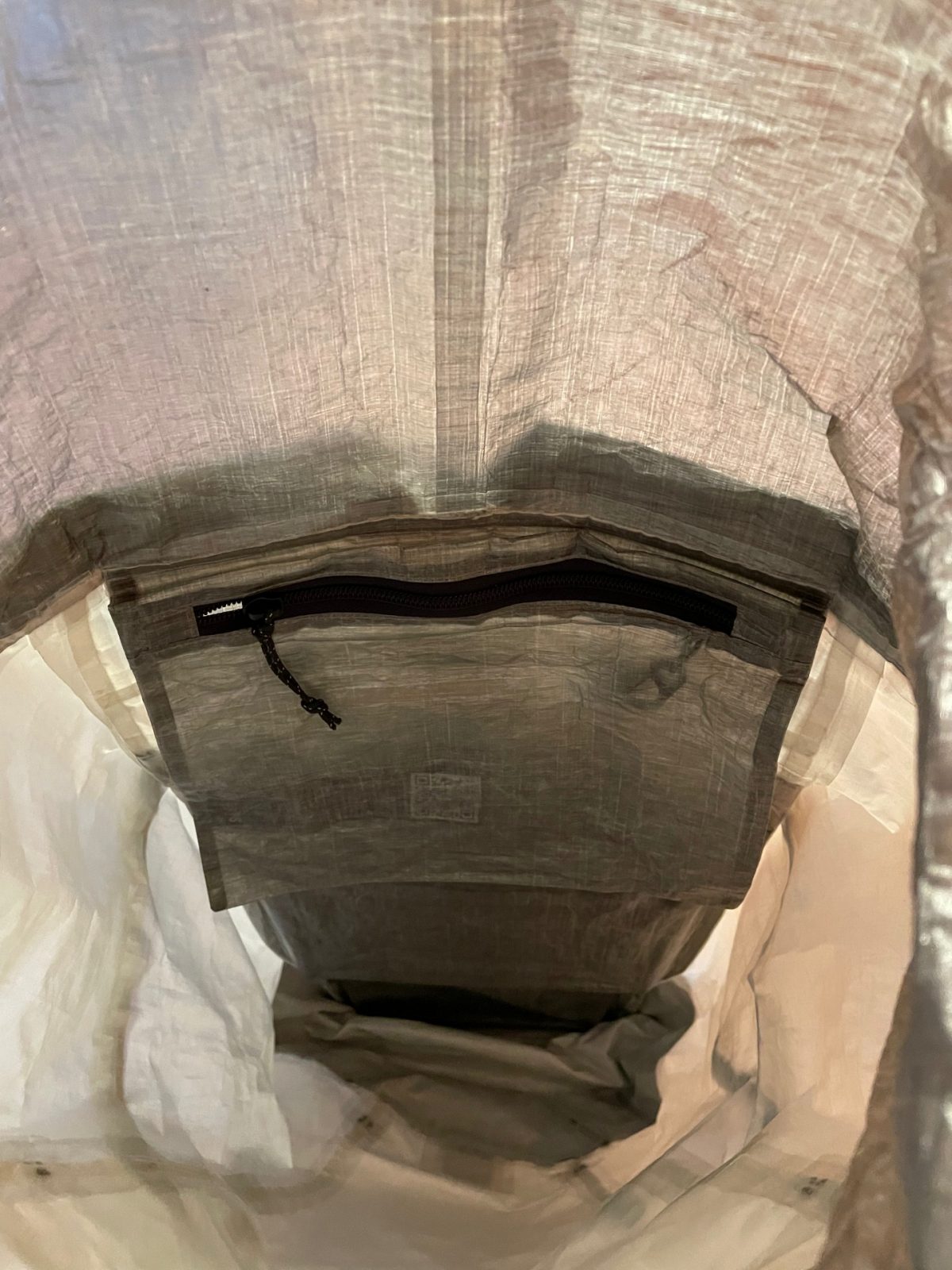
View down the belly of the ULTRA35. It’s a single storage compartment with a small, zipper-accessed storage flap. The inner storage flap includes a key clip.
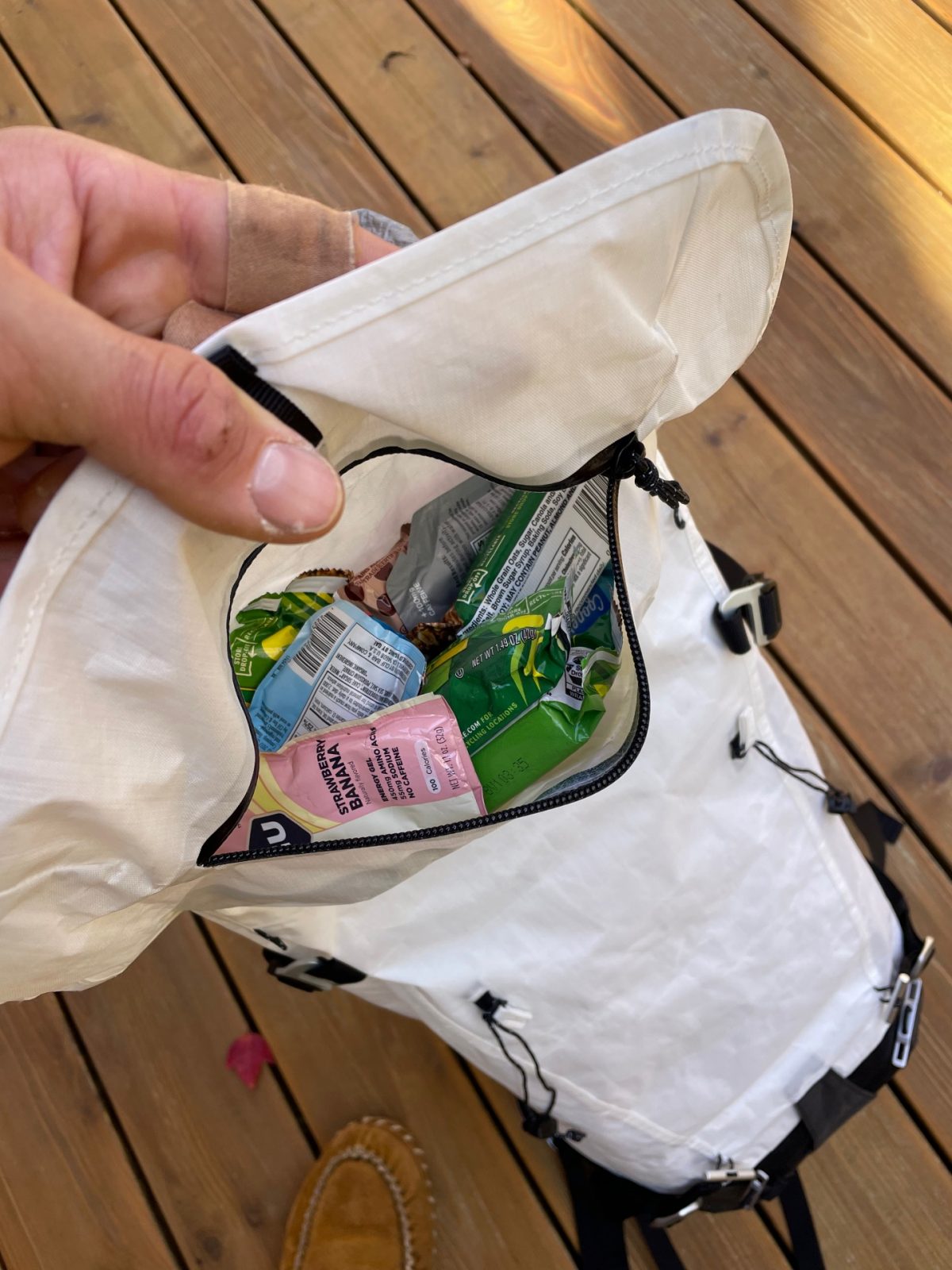
View into the lid pouch accessible from the exterior of the pack. The large assortment of plastic-wrapped nutrition shown here would leave plenty of additional room to accommodate a phone and InReach mini.
First impression: The Ultra35 is a beautifully designed, highly polished, minimalist 35-liter pack optimized for fast and light alpine objectives, but it may prove to have some drawbacks for more casual ski touring.
The pack is extraordinarily light. It weighs 495 grams when fully pared down (just a bit over one pound). To put that in perspective, it’s comparable to some 20L skimo racing packs. Dyneema works a lot of the magic here. Dyneema fabric—manufactured from the same fiber used in lightweight climbing slings and military-grade body armor—has become increasingly common in tent and pack construction in recent years, with big players like Hyperlite and many small niche producers making great use of it. For good reason. The stuff is stronger than steel, floats on water and is highly abrasion- and water-resistant. Dyneema fabric has a stiff, crinkly texture, so the pack doesn’t have the smooth, supple feel of nylon, but it’s safe to say that for the vast majority of users in this market, this will seem quite a small price to pay for its many advantages.
Better than simply being a (nearly) weightless pack, the Ultra35 is a pack that can be optimized for weight. In other words, almost every accessory on the pack can be removed to shed weight if it’s not needed for a particular mission—fully loaded with its standard accessories, the pack still weighs in at an impressively lean 840 grams.
What are these accessories?
—An elasticized mesh square of fabric with plastic hooklets at the corners that serves as a helmet carry
—A minimalist waist band with a plastic side-release buckle closure
—A chest strap (also with plastic side-release buckle closure) that attaches to daisy chains in the shoulder straps for easy adjustment
—Ice tool carries, with corded attachments for the tool shafts and corresponding aluminum stays for the picks
—Four ski carry straps (two on each side wall)
—A bit of pack suspension in the form of a thin foam pad and lightweight aluminum frame that slides into an internal slot in the back
Each of the above is easily removable. Conveniently, the pack comes with a separate small cinch sack, presumably for storing some of these items when removed.
The pack’s non-removable features include a roll-top closure system with lid flap for keeping the weather out and securing a climbing rope, a small internal purse-sized compartment with a zip closure, and a smallish outer compartment accessed by a weatherproof zipper on the lid flap. The outer compartment on the lid is small, but by no means tiny; it’s large enough to comfortably hold a phone, half a dozen bars, and a handful of gels.
Even without a field test, it’s clear that some design decisions made to shave weight will likely have consequences for comfortability. The frame sheet is minimalist, the hip belt is unpadded and constructed from very thin webbing, and the padding in the shoulder straps is minimal.
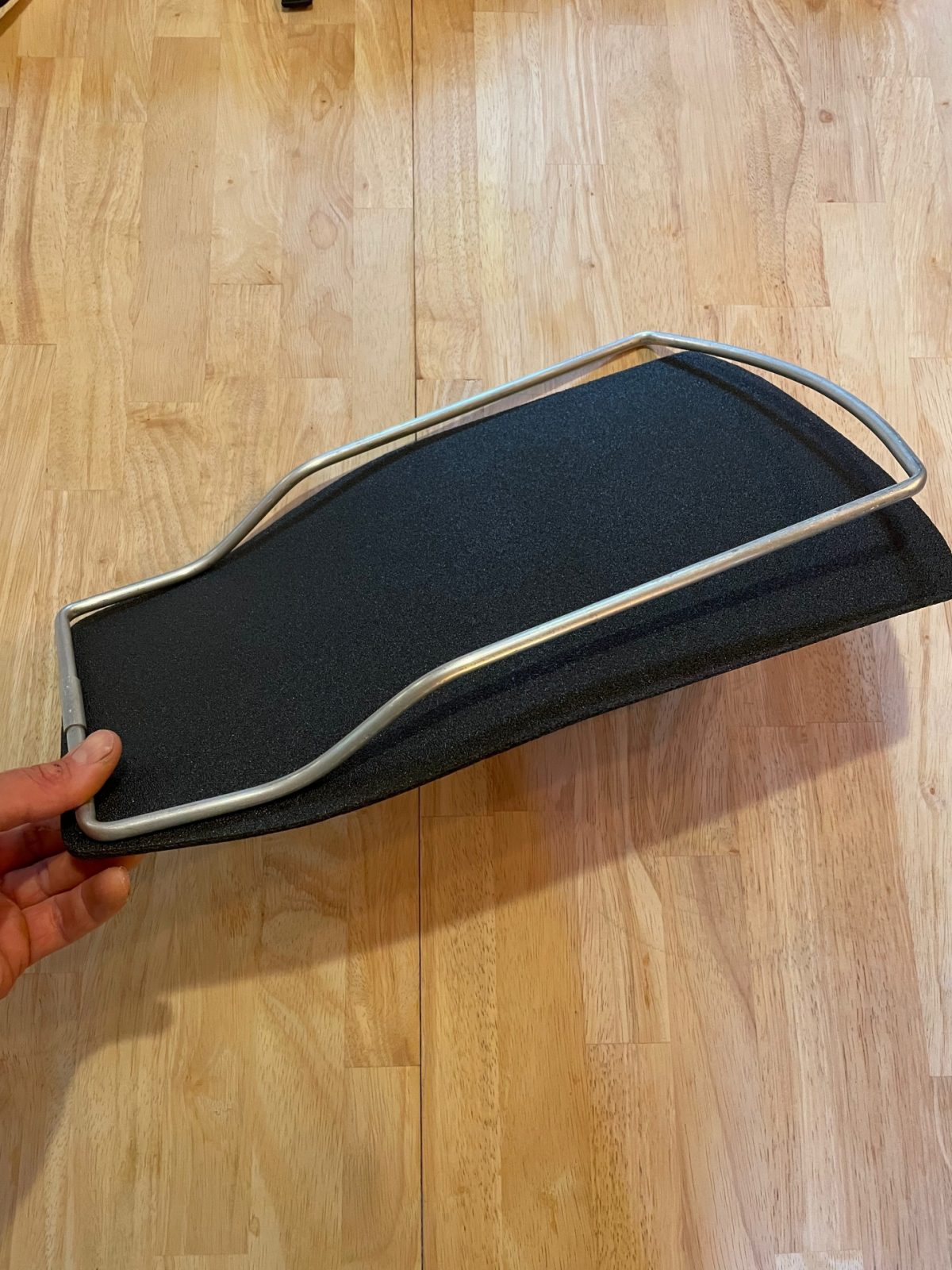
The ULTRA35 removable suspension. The biggest weight savings (165 grams) is achieved with removing this.
The pack makes an excellent first impression with respect to durability, especially given its extraordinarily lightweight. The Dyneema that wraps the pack’s bottom appears to be heavily reinforced (300D woven Dyneema, according to Samaya, which is double the thread weight of the pack’s main body). It’s a smart feature that isn’t present on many peer packs (the Hyperlite Prism and Arc’teryx Alpha series packs come to mind). This is where workhorse packs tend to show the earliest signs of wear, so I’m interested to see how it performs over the coming months. Other elements of the pack also give the appearance of impressive durability—the webbing that forms the “handle” above the shoulder straps (for lifting the pack) is beefy. The aluminum hooks used for two of the ski-carry straps and the over-the-top cinch strap also seem much sturdier than the plastic hooks often featured on these accessories.

Side view of the ULTRA35 fully laden with gear. In this photo, the interior of the pack contains a belay parka, crampons, ski crampons, a pair of skins, a full rack of cams and nuts, 8 ice screws, 8 alpine draws, an avalanche shovel and probe, a pair of gloves, 2 liters of water and 6 cliff bars. The outside holds a helmet, ice tools and skis.
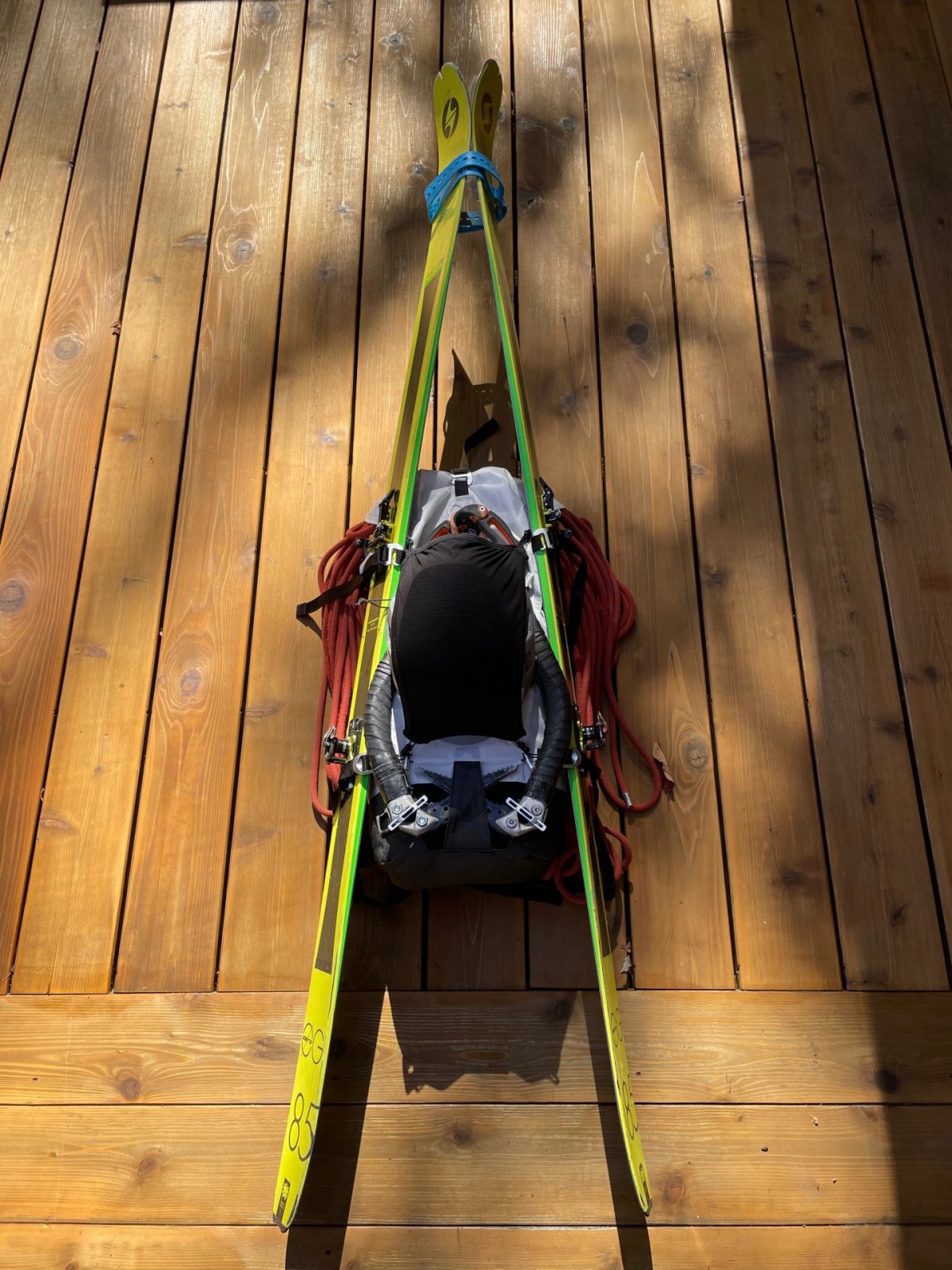
Straight-on view of the ULTRA35 holding the same gear. You can see that the ski tips resist being brought completely together in the A-frame ski carry with the pack so full of gear.
For ski touring, the pack appears to present three major drawbacks for some. First, it is a single compartment, accessible from the top (a roll-top closure system), so there’s no dedicated compartment for your shovel, probe and snow saw. There is also no side access or back panel access, which means you can expect to spend more time rummaging around from the top of the pack to find what you need (especially if you’re like me and aren’t always strategic enough when you load it up). Finally, there is no diagonal ski carry, so you’ll be limited to an A-frame style carry using the pack’s side wall straps without a mod. I strongly prefer the diagonal carry, so I plan to experiment this season with rigging one using a few of the pack’s existing sewn accessory loops.
For ski mountaineering missions, the pack lacks a few helpful features found on some peer high-performance alpine packs: it has no wand pockets built into the side walls (useful for glacier travel), and no exterior crampon pocket.
I also question how user-friendly the aluminum hooks will prove to be when operated with a gloved hand on the side of a mountain. The “teeth” on these hooks are deeply incut, so they are quite “hooky.” This makes them unlikely to become inadvertently unhooked in the alpine, but they’re also a little difficult to unhook when you want to. Not a big problem for the side straps, since they shouldn’t need to be unhooked in the field (just loosened), but the same type of hook is used for the over-the-top cinch closure, which may need to be hooked and unhooked frequently.
The ULTRA35 is a minimalist pack optimized for fast and light alpine missions. It seems to have a few drawbacks for more casual ski touring and is unlikely to provide a comfy experience for hauling a heavy load on a long day. Still, if the goal is high-end durability at the lowest weight possible, the Ultra35 makes a great first impression. We’ll report back when we’ve had a chance to beat it up a little in the mountains.
The Samaya ULTRA35 Specs:
Paired down weight: 495g
Full featured weight: 840g
Volume: 35L in main compartment
Bottom material: 300D Woven Dyneema®
Ice axe reinforcement: 1000D – Cordura®
Main body: Dyneema® Composite Fabric – 150D PES
Seams: 100% waterproof
Price: $450.00
Chris spent seven years as a corporate lawyer in Boston before heeding the call of the mountains. He’s now more likely to be seen wandering seasonally in the East and West with axes or skis, or missions combing the two. He lives in a log cabin he built with his wife in Sugar Hill, NH.

